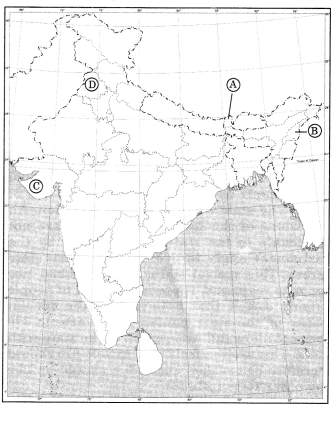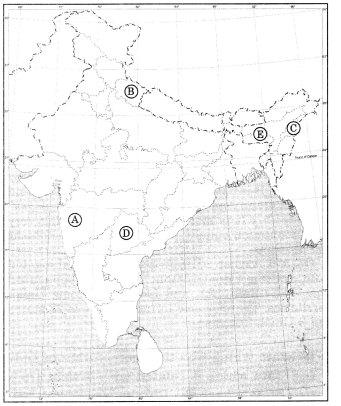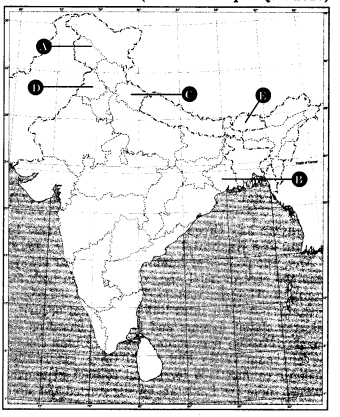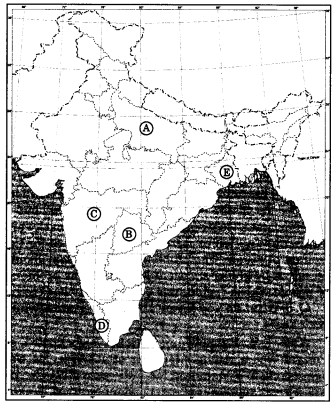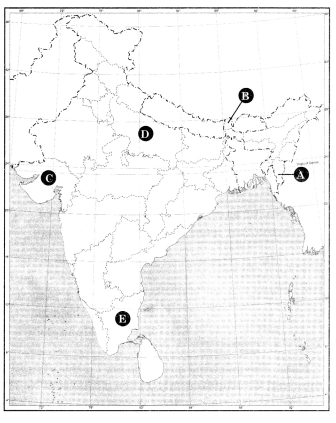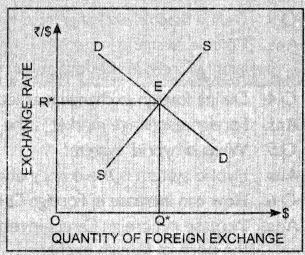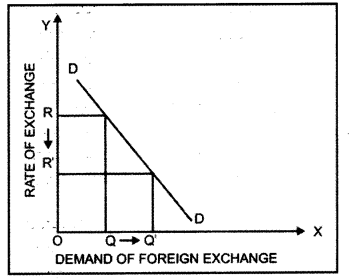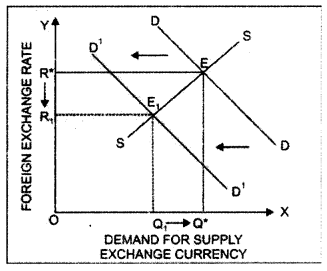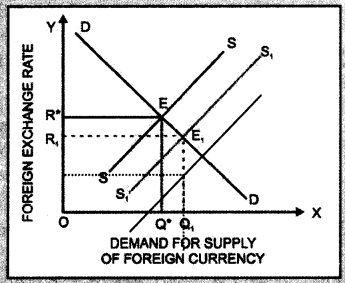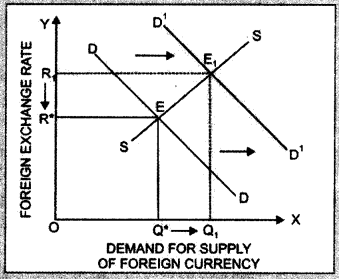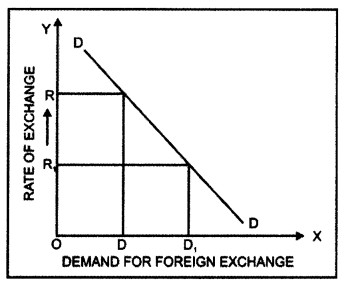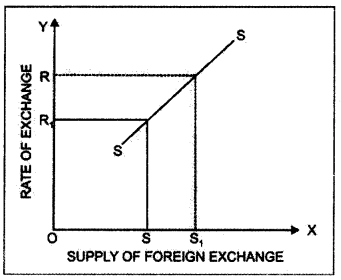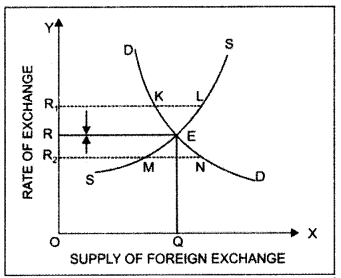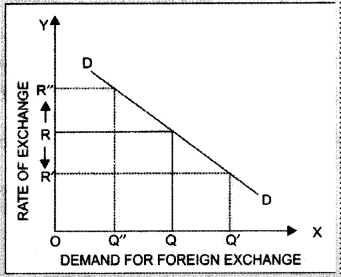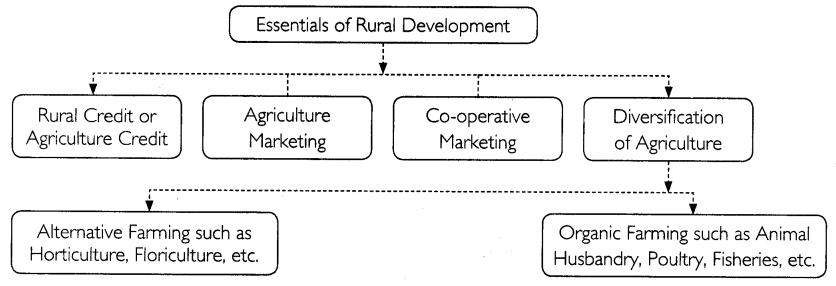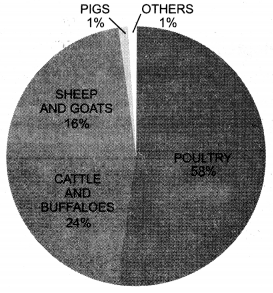Here we are providing Class 12 Hindi Important Extra Questions and Answers Aroh Chapter 3 कविता के बहाने, बात सीधी थी पर. Important Questions for Class 12 Hindi are the best resource for students which helps in class 12 board exams.
कविता के बहाने, बात सीधी थी पर Class 12 Important Extra Questions Hindi Aroh Chapter 3
प्रश्न 1.
कविता में कौन-कौन से उपकरण विद्यमान हैं?
उत्तर
कविता में जड़-चेतन के वे सभी उपकरण विद्यमान हैं जो अतीत, वर्तमान और भविष्य को आपस में जोड़ते हैं। इन्हीं से मनुष्य की अपार संभावनाएँ प्रकट होती हैं।
प्रश्न 2.
‘बात सीधी थी पर’ कविता में निहित संदेश स्पष्ट कीजिए।
उत्तर
‘बात सीधी थी पर’ कविता के माध्यम से कवि कुँवर नारायण ने उन रचनाकारों पर व्यंग्य किया है जो अपनी भावनाओं को अभिव्यक्ति प्रदान करने के लिए भाषा के साथ खिलवाड़ करते हैं। वे अपनी रचना में शब्दों का जाल रचकर पाठकों को भ्रमित करते हैं तथा आडंबरपूर्ण शब्द-योजना से उनकी वाह-वाही लूटते हैं, चाहे उनकी रचना का कथ्य पाठकों अथवा श्रोताओं की समझ में आया हो या नहीं।
कवि चाहता है कि रचनाकार को अपनी बात अत्यंत सहज तथा स्पष्ट शब्दों में कहनी चाहिए। कथ्य और भाषा का सही सामंजस्य बना रहना चाहिए, जिससे पाठक अथवा श्रोता तक उसकी बात सहज रूप से पहुँच सके।
प्रश्न 3.
कवि के अनुसार कोई बात पेचीदा कैसे हो जाती है? (C.B.S.E.Delhi 2017 Set-I)
उत्तर
कवि का मानना है कि जब अपनी बात को सहज और स्पष्ट रूप से न कह कर तोड़-मरोड़, उलट-पुलट अथवा घुमा-फिरा कर _कहते हैं तो कही हुई बात उलझती चली जाती है। ऐसी उलझन-भरी बात श्रोता अथवा पाठक समझ नहीं पाता। वह सोचता ही रह जाता है कि कहने वाला कह क्या रहा था? इस प्रकार की उलझी हुई बात प्रभावहीन हो जाती है।
प्रश्न 4.
बात ने, जो एक शरारती बच्चे की तरह
मुझसे खेल रही थी,
मुझे पसीना पोंछते देखकर पूछा
“क्या तुमने भाषा को
सहूलियत से बरतना कभी नहीं सीखा ?” इन पंक्तियों का काव्य-सौंदर्य स्पष्ट कीजिए।
उत्तर
इन पंक्तियों में कवि ने बात का मानवीकरण किया है। कवि काव्य-रचना में भाषा के सहज तथा प्रभावशाली प्रयोग पर बल दे रहा है। खड़ी बोली में रचित इन पंक्तियों की भाषा विदेशी, देशज तथा तद्भव शब्दों से युक्त है। छंद-मुक्त रचना है। मुहावरे का सहज रूप से प्रभावशाली प्रयोग किया गया है। अनुप्रास, मानवीकरण, उत्प्रेक्षा आदि अलंकार हैं। लाक्षणिकता एवं बिंब-विधान ने कथन को सुंदरता प्रदान की है।
प्रश्न 5.
कविता एक खिलना है फूलों के बहाने
कविता का खिलना भला फूल क्या जाने।
बाहर भीतर
इस घर, उस घर
बिना मुरझाए महकने के माने
फल क्या जाने? अवतरण का भाव सौंदर्य एवं काव्य स्पष्ट कीजिए।
उत्तर
भाव सौंदर्य-यह अवतरण कुँवर नारायण विरचित ‘कविता के बहाने’ नामक कविता से अवतरित है। इसमें कवि ने बताया है कि फूल के खिलने के साथ-साथ उसकी परिणाति भी सुनिश्चित है क्योंकि फूल कुछ समय खिलने के पश्चात मुरझा अवश्य ही जाता है, जबकि कविता यहाँ-वहाँ सब ओर खिलकर अपनी शोभा बिखेरती रहती है और वह कभी मुरझाती नहीं। काव्य-सौंदर्य प्रस्तुत अवतरण में कुँवर नारायण के फूल के विकास के साथ उसकी परिणाति का चित्रण किया है।
- भाषा सरल, सरस एवं भावपूर्ण है।
- तद्भव शब्दावली की अधिकता है।
- मुक्तक छंद का प्रयोग है।
- प्रसाद गुण एवं शांत रस है।
- अनुप्रास एवं उपमा अलंकार हैं।
- शैली सुरुचिपूर्ण एवं चित्रात्मक है।
प्रश्न 6.
‘कविता के बहाने’ कविता का केद्रीय भाव स्पष्ट करें।
उत्तर
कविता के बहाने’ कुँवर नारायण के ‘इन दिनों’ संग्रह से ली गई है। कविता के बहाने कविता में कवि ने चिड़िया तथा फूल से लेकर बच्चे तक की यात्रा है। एक तरफ प्रकृति है तो दूसरी तरफ भविष्य की ओर कदम बढ़ाता हुआ बच्चा है। यह स्पष्ट है कि चिड़िया के उड़ान की एक सीमा है।
फूल के खिलने के साथ ही उसकी परिणति निश्चित है लेकिन बच्चे के सपने असीम हैं। बच्चों के खेल में किसी भी प्रकार की सीमा का कोई स्थान नहीं है। कविता भी शब्दों का एक खेल है जिसमें जड़-चेतन, अतीत, वर्तमान और भविष्य साधन मात्र हैं। अत: जहाँ कहीं रचनात्मक ऊर्जा होती है वहाँ सीमाओं के बंधन स्वयं ही टूट जाते हैं।
प्रश्न 7.
बच्चा सब घर एक कैसे कर देता है?
उत्तर
बच्चा अत्यंत कोमल, निचेष्ट एवं चंचल होता है। उसे अपना-पराया, ईर्ष्या-द्वेष, अहं आदि का बोध नहीं होता। वह केवल अपनी मस्ती में मदमस्त होकर यहाँ-वहाँ खेलता रहता है। उसके खेल के सामने किसी भी घर की कोई सीमा बाधा उत्पन्न नहीं करती और वह सभी के आँगन को अपनी चंचलता एवं उमंग से देता है। इस प्रकार बच्चा अपने खेल एवं बाल क्रीड़ाओं से सब घर एक कर देता है।
प्रश्न 8.
कवि किस पाने का प्रयास कर रहा था और क्यों?
उत्तर
कवि सरल एवं स्पष्ट बात को कठिन एवं पचोदी भाषा के चंगुल से बाहर निकालकर उसे पुराने रूप में पाने का प्रयास कर रहा था। वह बात सरल एवं सीधी होने पर भी कठिन भाषा के चक्कर में टेढ़ी होकर फँस गई थी।
प्रश्न 9.
कवि किसकी वाह-वाही में डूब गया था? उसका क्या प्रभाव हुआ?
उत्तर
कवि तमाशबीनों की वाह-वाही में डूब गया था? उसके प्रभाव से कवि द्वंद्व में पड़ गया और उसने मुश्किल भरे धैर्य से समझे बिना ही बात को सहज और स्पष्ट करने की अपेक्षा कठिन क्ष के चक्कर में ही उलझा दिया। अंत में वह सरल, सीधी बात प्रभावहीन एवं अर्थहीन हो गई।
प्रश्न 10.
कवि के साथ बात किसके समान खेल रही थी? उसने कवि पर क्या व्यंग्य किया?
उत्तर
बात कवि के साथ एक नटखट एवं शरारती बच्चे के समान खेल रही थी। उसने कवि पर व्यंग्य करते हुए कहा कि आपको भाषा का सहज एवं सरल रूप से प्रयोग करना नहीं आता।
प्रश्न 11.
कविता के लिए शब्दों का संबंध किससे और कैसे है?
उत्तर
कविता के लिए शब्दों का संबंध सारे जड़-चेतन से है। यह अतीत, वर्तमान और भविष्य से जुड़ी हुई है। इसकी व्यापकता अपार है। इसकी कोई समय सीमा नहीं है। यह किसी बंधन में नहीं बँधती। इसके लिए न तो समय का बंधन है न तो भाषा का कोई बंधन है।
प्रश्न 12.
कविता का खिलना फलों के खिलने स श्रेष्ठ कैसे है?
उत्तर
कविता का खिलना फूल के खिलने का बहाना तो हो सकता है, पर फूल का खिलना कविता जैसी नहीं हो सकता। फूल खिलता है किंतु कुछ समय पश्चात वह मुरझा जाता है लेकिन कविता तो भावों की महक के लिए रहती है और बिना मुरझाए सदा प्रभाव डालती रहती है।
प्रश्न 13.
कवि ने ‘कविता के बहाने’ कविता को किसके समान और क्यों माना है?
उत्तर
कवि ने कविता को बच्चों के खेल के समान माना है। कविता की अपनी कोई सीमा नहीं होती है। इसी प्रकार बच्चों के खेल और सपनों की भी कोई सीमा नहीं होती है। वे अपने भावी जीवन की ओर उड़ान भरते हैं। कविता भी शब्दों का ऐसा अनूठा खेल है, जिस पर किसी का कोई बंधन नहीं है।
प्रश्न 14.
कवि ने कविता की तुलना फूलों से न करने की बात क्यों कही है?
उत्तर
फूल खिलते हैं, कुछ देर में मुरझा भी जाते हैं अर्थात वे सूखकर मिट जाते हैं, जबकि कविता में व्यप्त मधुर भाव कभी समाप्त नहीं होते। वे मधुर भाव तो सब जगह व्याप्त रहते हैं। वे सभी के हृदय में जीवन जीने की चाह उत्पन्न करते हैं। फूलों की महक और सुंदरता की तुलना किसी भी प्रकार की कविता से नहीं जा सकती।
प्रश्न 15.
‘कविता के बहाने’ कविता का प्रतिपाद्य लिखिए।
उत्तर
‘कविता के बहाने’ कुँवर नारायण की एक उद्देश्यपूर्ण कविता है। वैसे तो कुँवर की यह कविता एक यात्रा है जो चिड़िया, फूल एवं बालकों के खेल तक जाती है। कवि ने एक ओर जहाँ चिड़िया की उड़ान की सीमा को निश्चित माना है, फूलों की सुगंध एक समय सीमा तक मानी है, वहीं दूसरी ओर कविता में व्याप्त भावों की गति को अत्यंत व्यापक बताया है।
कवि के अनुसार कविता अपनी रचनात्मक ऊर्जा से घर, समय, भाषा एवं स्थान की सभी सीमाओं का तोड़ देने की प्रबल क्षमता रखती है।
प्रश्न 16.
कवि ने कविता और बच्चों में क्या समानता बताई है?
अथवा
‘कविता के बहाने’ कविता में कविता और बच्चे को समानांतर रखने के क्या कारण हो सकते हैं? (C.B.S.E. 2018)
उत्तर
कवि ने कविता और बच्चों में समानता बताई है कि कविता और बच्चे दोनों ही ऊँच-नीच, छोटे-बड़े, अपने-पराए, जात-पात आदि का भेदभाव नहीं जानते। ये दोनों सभी के हृदय में प्रेम-भाव समान रूप से उजागर करते हैं। कविता के भाव और बालकों के खेल अपनी ओर सभी को आकर्षित कर लेते हैं।
प्रश्न 17.
‘बात सीधी थी पर’ कविता में कवि ने मुख्य रूप से क्या कहना चाहा है?
उत्तर
‘बात सीधी थी पर’ कविता में कवि में कवि ने कथ्य और माध्यम के द्वंद्व को प्रस्तुत करते हुए कथ्य को स्पष्ट करने के लिए आडंबरपूर्ण शब्दावली के स्थान पर भाषा के सहज प्रयोग पर बल दिया है।
प्रश्न 18.
कवि कुंवर नारायण की भाषा-शैली पर प्रकाश डालिए।
उत्तर
कवि ने ‘कविता के बहाने’ और ‘बात सीधी थी पर’ अपनी इन दोनों कविताओं में सामान्य बोलचाल की भाषा खड़ी बोली का सहज प्रयोग किया है। कवि ने अपनी दोनों कविताओं में तत्सम, तद्भव-युक्त शब्दावली का प्रयोग किया है।
कवि ने प्रसाद गुण का सहज स्वभाविक प्रयोग किया है। इसी कारण उनकी भाषा सरल, सहज एवं भावानुकूल बन पड़ी है। कवि ने दोनों ही कविताओं को छंद-रहित लिखा है। प्रतीकात्मकता एवं व्यंजनात्मकता सर्वत्र विद्यमान है। कवि ने दोनों ही कविताओं को उपदेशात्मक शैली में लिखा है।
प्रश्न 19.
कविता ‘बात सीधी थी पर’ में कवि की बात कहाँ और कैसे फंस गई?
उत्तर
‘बात सीधी थी पर’ कुँवर नारायण की एक उद्देश्यपूर्ण कविता है। कवि ने अपनी इस कविता में अपनी सीधी, सरल एवं आसान बात को प्रकट करके सभी लोगों से प्रशंसा पानी चाही है। लेकिन प्रशंसा पाने के चक्कर में उसे शब्दों का झूठा जाल भी बुनना पड़ा, जिस जाल में वह स्वयं फंसता चला गया। इसी कारण वह अपनी बात को कहने के लिए बनाए गए शब्द-जाल में फंस कर रह गया।
सप्रसंग व्याख्या, अर्थग्रहण एवं सौंदर्य-सराहना संबंधी प्रश्नोत्तर
1. कविता एक उड़ान है चिड़िया के बहाने
कविता की उड़ान भला चिड़िया क्या जाने
बाहर भीतर
इस घर, उस घर
कविता के पंख लगा उड़ने के माने
चिडिया क्या जाने? (C.B.S.E. Sample Paper) (C.B.S.E. Outside Delhi, 2013, Set-1)
शब्दार्थ : माने-मायने, अर्थ।
प्रसंग : प्रस्तुत पंक्तियाँ आरोह भाग-2 में संकलित कविता ‘कविता के बहाने’ से ली गई हैं जिसके रचयिता श्री कुँवर नारायण हैं। कविता को मन की उड़ान स्वीकार किया जाता है। कोई चिड़िया भी उड़ती है पर चिड़िया और कविता की उड़ान एकसमान नहीं है। इन दोनों में बहुत बड़ा अंतर है।
व्याख्या : कवि कहता है कि कविता एक उड़ान है। वह किसी चिड़िया की उड़ान के बहाने व्यक्त तो हो सकती है लेकिन कविता में निहित भावों की उड़ान में जो गुण और व्यापकता विद्यमान है, वह भला चिड़िया की सीमित उड़ान में कैसे संभव हो सकती है।
चिड़िया तो एक घर से दूसरे घर, बाहर से भीतर या भीतर से बाहर ही उड़ान भरती है। उसकी उड़ान की सीमा बँधी रहती है लेकिन कवि के मन में उत्पन्न होने वाले भावों की कोई सीमा नहीं है। भावों के पंख तो असीम दूरी तथा अनंत ऊँचाई तक उड़ान भर सकते हैं। कविता के द्वारा पंख लगाकर उड़ने का अर्थ तो किसी भी सीमा में न बँधना है। भला एक चिड़िया क्या जाने कि कविता की उड़ान में कितनी व्यापकता है।
अर्थग्रहण एवं सौंदर्य-सराहना संबंधी प्रश्नोत्तर
प्रश्न
1. इस अवतरण के कवि तथा कविता का नाम लिखिए।
2. ‘कविता एक उड़ान है’ पंक्ति में निहित भाव स्पष्ट कीजिए।
3. कविता पंख लगाकर कहाँ-कहाँ उड़ सकती है?
4. ‘चिड़िया क्या जाने?’ में निहित व्यंग्य स्पष्ट कीजिए।
5. इस अवतरण का काव्य-सौंदर्य स्पष्ट कीजिए।
6. कविता की तुलना चिड़िया से क्यों की गई है? (Delhi C.B.S.E. 2016)
7. चिड़िया कविता की उड़ान को क्यों नहीं समझ सकती?
उत्तर
1. इस अवतरण के कवि का नाम श्री कुँवर नारायण तथा कविता का नाम ‘कविता के बहाने’ है।
2. इस पंक्ति का भाव यह है कि कविता एक उड़ान की तरह समकालीन समाज का यथार्थ चित्रण करने के लिए अपनी उड़ान भरती रहती है।
3. कविता पंख लगाकर आंतरिक मन, बाह्य समाज, परिदृश्य तथा इस घर से उस घर तक उड़ सकती है।
4. कवि का कथन है कि जो उड़ान कविता भर सकती है तथा जिस स्थान पर वह जा सकती है, उस स्थान पर चिड़िया कभी नहीं जा
5. काव्य-सौंदर्य
- कवि ने कविता में अपार संभावनाओं को प्रकट किया है। कवि की कल्पना सीमा-रहित हो सकती है। तभी तो कहा जाता है-जहाँ न पहुँचे रवि, वहाँ पहुँचे कवि।
- मुक्त छंद का प्रयोग है पर कवि ने तुक का प्रयोग कर लय उत्पन्न करने का प्रयत्न किया है।
- प्रश्न शैली ने नाटकीयता की सृष्टि की है।
- खड़ी बोली का प्रयोग है जिसमें तद्भव शब्दावली की अधिकता है।
- प्रसाद गुण की प्रधानता है।
- शांत रस विद्यमान है।
- लाक्षणिकता के प्रयोग ने कवि के कथन को गहनता प्रदान की है।
- अनुप्रास और मानवीकरण अलंकारों का सहज प्रयोग किया गया है।
6. कविता की तुलना चिड़िया से इसलिए की गई है क्योंकि कविता और चिड़िया में कुछ-न-कुछ समानता होती है। चिड़िया हवा में उड़ान भरती है और कविता कवि की कल्पना में उड़ान भरती है। उड़ती चिड़िया आँखों को लुभाती है और सुनाई गई कविता इनसानी मन-मस्तिष्क को अच्छी लगती है।
7. चिड़िया कविता की उड़ान को इसलिए नहीं समझ सकती क्योंकि चिड़िया की उड़ान सीमित होती है।
2. कविता एक खिलना है फूलों के बहाने
कविता का खिलना भला फूल क्या जाने के
बाहर भीतर
इस घर, उस घर
बिना मुरझाए महकने के माने
फूल क्या जाने? (C.B.S.E. Sample Paper)
प्रसंग : प्रस्तुत पंक्तियाँ हमारी पाठ्य-पुस्तक आरोह भाग-2 में संकलित ‘कविता के बहाने’ से ली गई हैं जिसके रचयिता श्री कुंवर नारायण हैं। कवि का मानना है कि कविता का विषय चाहे कोई हो, पर कविता हर विषय से बढ़कर होती है। कविता में चाहे फूलों के खिलने का वर्णन हो पर कविता तो उससे बढ़कर ही होती है।
व्याख्या : कवि कहता है किसी कविता में सुंदर फूलों के खिलने का वर्णन हो सकता है, उनकी शोभा का उल्लेख हो सकता है पर वास्तव में कविता की सुंदरता को फूलों का खिलना नहीं समझा जा सकता। फूल खिलते हैं, कुछ देर महकते हैं और फिर मुरझा जाते हैं। वे सूख कर मिट जाते हैं पर कविता के मधुर भाव तो कभी नहीं मुरझाते।
वे मधुर भाव तो बाहर-भीतर, इस घर में, उस घर में, सब जगह व्याप्त रहते हैं। सब के हृदय में जीने की चाह उत्पन्न करते हैं। फूलों की महक और सुंदरता की तुलना किसी भी प्रकार कविता से नहीं की जा सकती।
अर्थग्रहण एवं सौंदर्य-सराहना संबंधी प्रश्नोत्तर
प्रश्न
1. कविता क्या है?
2. फूल क्या नहीं जानता?
3. उपर्युक्त पद्यांश का काव्य-सौंदर्य स्पष्ट कीजिए।
4. कविता के खिलने और फूलों के खिलने में क्या साम्य-वैषम्य है? (Delhi C.B.S.E. 2016)
5. काव्यांश के आधार पर कविता के दो लक्षणों को स्पष्ट कीजिए।
उत्तर
1. कविता की रचना ठीक वैसे ही जैसे फूलों का खिलना।
2. फूल कविता का खिलना नहीं जानता। उसे हर जगह कविता की तरह प्रवेश करना तथा बिना मुरझाए महकना नहीं आता।
3. काव्य-सौंदर्य
- कवि ने कविता की व्यापकता और महत्व का प्रतीकात्मक प्रस्तुतीकरण किया है।
- मक्त छंद का प्रयोग है। कवि ने तक का प्रयोग किया है।
- अनुप्रास और मानवीकरण अलंकारों का सहज-स्वाभाविक प्रयोग किया गया है।
- प्रसाद गुण विद्यमान है।
- लाक्षणिकता ने भावों को गहनता प्रदान की है।
- शांत रस है।
- खड़ी बोली के प्रयोग में तद्भव शब्दावली की अधिकता है।
- प्रश्न-शैली ने नाटकीयता की सृष्टि की है।
4. कविता का खिलना असीमित होता है। कविता एक बार खिलकर बिना मुरझाए सदैव महकती है जबकि फूल का खिलना सीमित है। यह सूर्योदय के समय खिलता और सूर्यास्त के समय मुरझा जाता है।
5. कविता की उड़ान असीमित होती है। कविता बिना मुरझाए महकती रहती है।
3. कविता एक खेल है बच्चों के बहाने
बाहर भीतर
यह घर, वह घर सब घर एक कर देने के माने
बच्चा ही जाने। (C.B.S.E. Sample Paper)
प्रसंग : प्रस्तुत अवतरण श्री कुँवर नारायण द्वारा रचित कविता ‘कविता के बहाने’ से अवतरित किया गया है जिसे हमारी पाठ्य-पुस्तक आरोह भाग-2 में संकलित किया गया है। कविता की रचना कवि के हृदय की कोमल पुकार होती है। वह अपने आप में एक नया संसार होता है। वह छोटे बच्चों के खेल की तरह होती है जो किसी बंधन में बंधी हुई नहीं होती। उसका संबंध तो सबसे होता है, हर काल से होता है, हर स्थान से होता है।
व्याख्या : कवि कहता है कि कविता को किसी बहाने की आवश्यकता नहीं होती। वह तो बच्चों के खेल की तरह है जो कभी भी, कहीं भी, किसी भी स्थान पर प्रकट हो जाती है। बच्चे अपने खेल में मग्न हो बाहर-भीतर की परवाह नहीं करते। वे इस घर से उस घर में, हर घर में अपने खेल का स्थान ढूँढ़ लेते हैं, उसी प्रकार कविता अतीत के, वर्तमान के, भविष्य के प्रसंगों को प्रकट कर लेती है।
वह हर समय के भावों को व्यक्त कर लेती है। कविता की रचनात्मकता में तो अपूर्व ऊर्जा छिपी हुई है। वह किसी भी बंधन में बँधती नहीं है। वह बच्चों के खेल की तरह बेपरवाह है। वह बच्चे के खेल की तरह किसी एक स्थान से बँधी हुई नहीं है।
अर्थग्रहण एवं सौंदर्य-सराहना संबंधी प्रश्नोत्तर
प्रश्न
1. कविता क्या है?
2. सभी घरों को एक समान करने के बहाने कौन जानता है?
3. इस काव्यांश के कवि तथा कविता का नाम बताएँ।
4. उपर्युक्त काव्यांश का काव्य-सौंदर्य स्पष्ट कीजिए।
उत्तर
1. कविता एक खेल है।
2. सभी घरों को एक समान करने के बहाने बच्चा ही जानता है।
3. इस काव्यांश के कवि का नाम श्री कुँवर नारायण है। इस काव्यांश की कविता का नाम ‘कविता के बहाने’ है।
4. काव्य-सौंदर्य
- कवि ने कविता की रचनात्मक व्यापकता को प्रकट किया है जो किसी भी सीमा में बँधकर नहीं रहती।
- खड़ी बोली का प्रयोग किया गया है जिसमें सामान्य बोल-चाल के शब्दों की अधिकता है।
- प्रसाद गुण है।
- लक्षणा शब्द-शक्ति ने कवि के कथन को गहनता-गंभीरता प्रदान की है।
- प्रतीकात्मकता विद्यमान है।
- अनुप्रास का प्रयोग है।
- मुक्त छंद का प्रयोग है पर कवि ने लयात्मकता हेतु तुक का प्रयोग भी किया है।
- शांत रस है।
4. बात सीधी थी पर एक बार
भाषा के चक्कर में
ज़रा टेढ़ी फंस गई।
उसे पाने की कोशिश में
भाषा को उलटा-पलटा
तोड़ा मरोड़ा घमाया फिराया
कि बात या तो बने
या फिर भाषा से बाहर आए
लेकिन इससे भाषा के साथ-साथ
बात और भी पेचीदा होती चली गई। (C.B.S.E. Delhi 2008,C.B.S.E. Sample Paper-1, 2010 Set-1, 2011 Set-III)
शब्दार्थ : सीधी-सरल, सहज। पेचीदा-कठिन, मुश्किल।
प्रसंग : प्रस्तुत पंक्तियाँ कुँवर नारायण द्वारा रचित कविता ‘बात सीधी थी पर’ से ली गई हैं। इस कविता में कवि ने कथ्य और माध्यम के वंद्व को प्रस्तुत करते हुए भाषा के सहज प्रयोग पर बल दिया है।
व्याख्या : कवि कहता है कि जब भी कवि अपनी सीधी-सादी भावनाओं को व्यक्त करना चाहता है तो भाषा के चक्कर में फंसकर वह अपनी बात को सहज रूप से कह नहीं पाता जिससे उसकी बात बिगड़ जाती है। वह फिर से कोशिश करता है और भाषा के नए-नए शब्दों को उलट-पुलट और तोड़-मरोड़ कर प्रयोग करता है अर्थात भाषा में अनेक प्रकार के परिवर्तन करता है कि किसी प्रकार से उसकी बात बन जाए परंतु भाषा के आडंबरपूर्ण प्रयोगों से उसकी बात स्पष्ट न होकर और अधिक उलझती गई तथा उसे समझना और भी अधिक कठिन हो गया। वह कथ्य को जितना अधिक सहज बनाना चाहता था, भाषा के जाल में उलझ कर वह और भी अधिक असहज हो गई।
अर्थग्रहण एवं सौंदर्य-सराहना संबंधी प्रश्नोत्तर
प्रश्न
1. बात किसके चक्कर में कैसे फैंस गई?
2. यहाँ कवि किसको पाने की कोशिश करता है?
3. बात को प्राप्त करने के लिए कवि को क्या करना पड़ा?
4. बात बाहर निकलने की बजाय कैसी हो गई?
5. इस काव्यांश का काव्य-सौंदर्य स्पष्ट कीजिए।
उत्तर
1. बात भाषा के चक्कर में टेढ़ी फँस गई।
2. यहाँ कवि टेढ़ी फँसी हुई बात को पुनः पाने की कोशिश करता है।
3. बात को प्राप्त करने के लिए कवि ने भाषा को उलटा-पलटा, उसे तोड़ा-मरोड़ा तथा अनेक तरह से घुमाया-फिराया।
4. बात बाहर निकलने की अपेक्षा और अधिक पेचीदा हो गई।
5. काव्य-सौंदर्य
- कवि का मानना है कि जब कोई रचनाकार अपनी बात को चमत्कारपूर्ण शब्दावली के माध्यम से व्यक्त करना चाहता है तो उसकी बात स्पष्ट होने के स्थान पर और भी अधिक उलझती जाती है।
- सहज, सरल, व्यावहारिक, प्रवाहमयी भाषा है।
- अनुप्रास तथा पुनरुक्ति प्रकाश अलंकार है।
- मुक्त छंद की रचना है।
- मुहावरे का सहज भाव से प्रयोग किया गया है।
- लाक्षणिकता का गुण विद्यमान है।
5. सारी मुश्किल को धैर्य से समझे बिना
मैं पेंच को खोलने के बजाए
उसे बेतरह कसता चला जा रहा था
क्योंकि इस करतब पर मुझे
साफ़ सुनाई दे रही थी
तमाशबीनों की शाबाशी और वाह वाह!
आखिरकार वही हुआ जिसका मुझे डर था
जोर जबरदस्ती से बात की चूड़ी मर गई (C.B.S.E. Sample Paper-I)
और वह भाषा में बेकार घूमने लगी। (A.I. C.B.S.E. 2009, 2010 Set-1, 2011 Set-III, 2012 Set-1)
शब्दार्थ : मुश्किल-कठिनता। बेतरह-अनुचित रूप से। पेंच-ऐसा कौल जिसके आधे भाग पर चूड़ियाँ बनी होती हैं; घुमाव, चक्कर, उलझन। धैर्य-धीरता, चित्त को स्थिर रखना। करतब-कार्य, करामात।
प्रसंग : प्रस्तुत पंक्तियाँ कुँवर नारायण द्वारा रचित कविता ‘बात सीधी थी पर’ से ली गई हैं। इस कविता में कवि ने कथ्य और माध्यम के वंद्व को प्रस्तुत करते हुए कथ्य को स्पष्ट करने के लिए भाषा के सहज प्रयोग पर बल दिया है।
व्याख्या : कवि कहता है कि वह जब भी कोई बात कहने लगता है शब्द-जाल में उलझकर उसकी बात और भी उलझ जाती है। अपने कथ्य की विभिन्न कठिनाइयों को धीरता से समझे बिना वह उलझन को और अधिक उलझाता जाता है। जैसे कि किसी पेंच को जबरदस्ती कसा जाए और वह ढीली पड़ जाएँ।
मेरे इस प्रकार के भाषा के प्रयोगों पर मुझे सुनने वाले मेरे कथ्य को समझे बिना ही मेरे शब्द-चयन पर ही मुझे शाबाशी देने लगते हैं तथा मेरे शब्दाडंबर की प्रशंसा करने लगते हैं। इससे यही होता है कि जैसे पेंच के साथ ज़बरदस्ती करने से उसकी चूड़ियाँ समाप्त हो जाती हैं, उसी प्रकार से मेरी जो बात है उसका प्रभाव समाप्त हो जाता है और वह मात्र शब्दों का जाल बनकर रह जाती है।
अर्थग्रहण एवं सौंदर्य-सराहना संबंधी प्रश्नोत्तर
प्रश्न
1. इस काव्यांश के कवि तथा कविता का नाम बताएँ।
2. कवि क्या करतब कर रहा था?
3. कवि को करतब करते समय कौन लोग और क्या दे रहे थे?
4. कवि के करतब में आखिरकार क्या हुआ? (Delhi C.B.S.E. 2016)
5. उपर्युक्त काव्यांश का काव्य-सौंदर्य स्पष्ट कीजिए।
उत्तर
1. इस काव्यांश के कवि का नाम श्री कुँवर नारायण है तथा कविता का नाम ‘बात सीधी थी पर’ है।
2. कवि सारी मुश्किलों को समझे बिना पेंच को बेतरह कसता चला जा रहा था।
3. कवि को करतब करते समय तमाशबीन लोग अपनी शाबाशी और वाह-वाही दे रहे थे।
4. कवि के करतब में आखिरकार बात के साथ जोर जबरदस्ती करने से उसकी चूड़ी मर गई और वह भाषा में बेकार घूमने लगी।
5. काव्य-सौंदर्य
- कवि का मानना है कि जब अपनी बात को सहज भाव से व्यक्त नहीं किया जाता तो वह बात प्रभावहीन हो जाती है।
- भाषा सहज, सरल, तद्भव तथा विदेशी शब्दों से युक्त है।
- अनुप्रास तथा पुनरुक्ति प्रकाश अलंकार हैं।
- मुक्त छंद की रचना है।
- लाक्षणिकता विद्यमान है।
- बिंब विधान के द्वारा कथन में वक्रता उत्पन्न की गई है।
6. हार कर मैंने उसे कील की तरह
उसी जगह ठोंक दिया।
ऊपर से ठीक ठाक
पर अंदर से
न तो उसमें कसाव था
न ताकत।
बात ने, जो एक शरारती बच्चे की तरह
मुझसे खेल रही थी,
मुझे पसीना पोंछते देखकर
पूछा”क्या तुमने भाषा को
सहूलियत से बरतना कभी नहीं सीखा?” (C.B.S.E. Delhi 2008,A.L.C.B.S.E. 2009, 2011 Set-III, 2012 Set-I,A.L.C.B.S.E. 2016,C.B.S.E.Outside Delhi 2013, Set-1)
शब्दार्थ : कसाव-कसने का भाव, खिचाव, गहराई, गठन। बरतना-व्यवहार में लाना। सहूलियत-सहजता।
प्रसंग : प्रस्तुत पंक्तियाँ कुँवर नारायण द्वारा रचित कविता ‘बात सीधी थी पर’ से ली गई हैं। इस कविता में कवि ने कथ्य और माध्यम के द्वंद्व को प्रस्तुत करते हुए कथ्य को स्पष्ट करने के लिए आडंबरपूर्ण शब्दावली के स्थान पर भाषा के सहज प्रयोग पर बल दिया है।
व्याख्या : कवि कहता है कि जब उससे उसकी बात स्पष्ट न हो सकी तथा और भी अधिक उलझती गई तो उसने उसे उसी स्थान पर वैसे ही छोड़ दिया जैसे पेंच की चूड़ियाँ मर जाने पर उसे कील की तरह उसी स्थान पर ठोंक दिया जाता है। ऐसी स्थिति में ऊपर से सब कुछ सुंदर और आकर्षक लगता है परंतु उसमें सहज रूप से कसाव और ताकत नहीं आ पाती। आडंबरपूर्ण शब्दावली से वाह-वाही तो मिल जाती है परंतु बात स्पष्ट नहीं हो पाती।
इसलिए जब मैं अपनी बात को स्पष्ट न कर सका तो एक शरारती बच्चे के समान मुझसे खेलने वाली बात ने मुझे पसीना पोंछते देखकर मुझसे पूछा कि क्या मैंने भाषा को सहजता से व्यवहार में लाना नहीं सीखा है? वह जानना चाहता था कि मैं शब्दजाल में फंस कर क्यों अपनी बात को उलझाता गया जबकि सहज, सरल भाषा में अपनी बात कहकर मैं सबको अपनी बात समझा सकता था।
अर्थग्रहण एवं सौंदर्य-सराहना संबंधी प्रश्नोत्तर
प्रश्न
1. कवि किससे हार गया और उसने क्या किया?
2. बात का स्वरूप कैसा था?
3. बात कवि के साथ कैसे खेल रही थी?
4. बात ने कवि से क्या पूछा?
5. इस अवतरण के काव्य-सौंदर्य पर प्रकाश डालिए।
6. बात की चूड़ी मरने का भाव स्पष्ट कीजिए।
7. ‘बात को कील की तरह ठोंकना’ क्या है? ऐसा क्यों किया जाता है?
8. टिप्पणी कीजिए कि बात और भाषा परस्पर जुड़े होते हैं।
9. भाषा में कसाव न हो तो क्या परिणाम होगा?
उत्तर
1. कवि बात से हार गया। उसने हारकर उसे एक कील के समान उसी जगह ठोंक दिया।
2. बात ऊपर से तो ठीक-ठाक थी लेकिन अंदर से न तो उसमें कसाव था और न ही ताकत थी।
3. बात कवि के साथ एक शरारती बच्चे के समान खेल रही थी।
4. बात ने कवि से यह पूछा कि क्या तुमने भाषा को सहूलियत से बरतना कभी नहीं सीखा।
5. काव्य-सौंदर्य
- कवि का मानना है कि अच्छी कविता की रचना करने के लिए आडंबरपूर्ण शब्दावली को चुनने की आवश्यकता नहीं होती बल्कि सहज भाषा के प्रयोग से ही अच्छी कविता की रचना होती है।
- भाषा सहज, सरल, भावपूर्ण तथा तद्भव और विदेशी शब्दों से युक्त है।
- मानवीकरण और अनुप्रास अलंकार हैं।
- मुक्त छंद की रचना है।
- लाक्षणिकता का गुण विद्यमान है।
- आकर्षक बिंब विधान की योजना की गई है।
- मुहावरों का सहज रूप से प्रभावशाली प्रयोग किया गया है।
6. इस कथन का भाव है-बात का प्रभावहीन हो जाना। बार-बार परिवर्तन से बात प्रभावहीन हो जाती है।
7. बात में कसावट अथवा गंभीरता न होना। ऐसा इसलिए किया जाता है कि बात की कसावट कम हो जाती है।
8. बात को प्रकट करने के लिए भाषा की आवश्यकता पड़ती है। बिना भाषा के बात अधूरी बनकर रह जाती है। इस प्रकार बात और भाषा का अनूठा संबंध है।
9. भाषा में कसाव न हो तो वह आपका उद्देश्य पूर्ण नहीं कर पाएगी वह प्रभावहीन, कमजोर, व्यर्थ और निरर्थक बन जाएगी।
